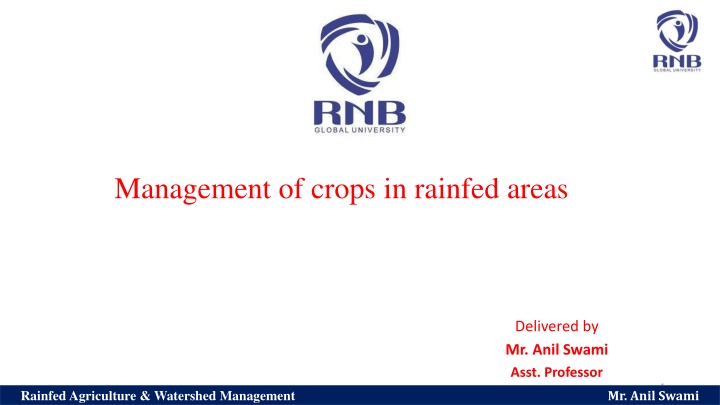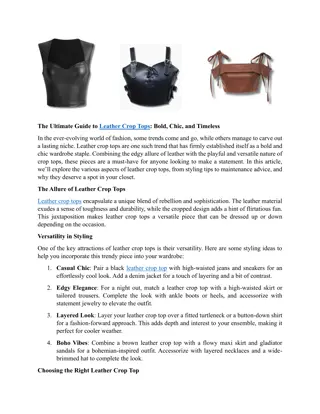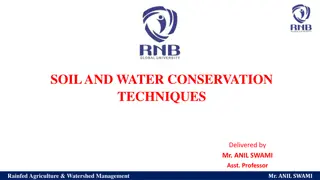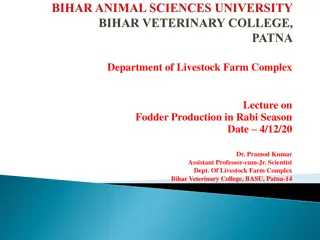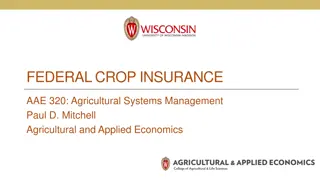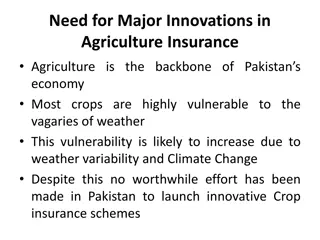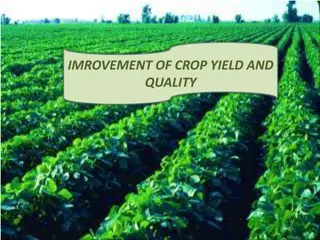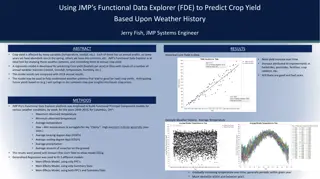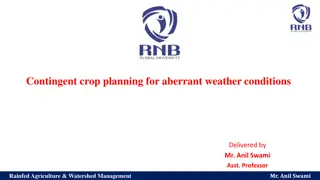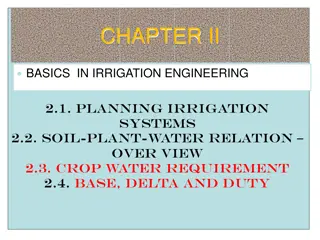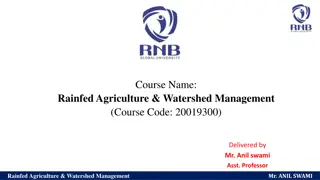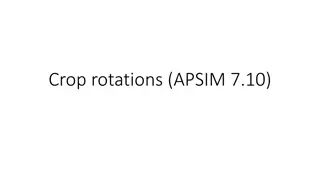Efficient Crop Management in Rainfed Areas by Mr. Anil Swami
Efficient crop management in rainfed areas is crucial for sustainable agricultural practices. Mr. Anil Swami, an Assistant Professor specializing in Rainfed Agriculture & Watershed Management, emphasizes the importance of soil and climatic conditions, water harvesting techniques, contingent crop planning, and soil conservation. The management practices discussed include efficient cropping systems, double cropping strategies, intercropping options, and choosing suitable crops and cultivars for drylands. These techniques aim to optimize crop production in rainfed regions by addressing soil moisture limitations and maximizing resource utilization.
Download Presentation

Please find below an Image/Link to download the presentation.
The content on the website is provided AS IS for your information and personal use only. It may not be sold, licensed, or shared on other websites without obtaining consent from the author.If you encounter any issues during the download, it is possible that the publisher has removed the file from their server.
You are allowed to download the files provided on this website for personal or commercial use, subject to the condition that they are used lawfully. All files are the property of their respective owners.
The content on the website is provided AS IS for your information and personal use only. It may not be sold, licensed, or shared on other websites without obtaining consent from the author.
E N D
Presentation Transcript
Management of crops in rainfed areas Delivered by Mr. Anil Swami Asst. Professor 1 Mr. Anil Swami Mr. Anil Swami Rainfed Agriculture & Watershed Management Rainfed Agriculture & Watershed Management
Objective:- Tell the soil and climatic conditions prevalent in rainfed areas. Interpret various water harvesting techniques and their efficient utilization. Apply contingent crop planning for aberrant weather conditions. Examine the seasonal rainfall and different types of watershed and its components. Select soil and water conservation techniques to avoid their losses. 2 Mr. Anil Swami Rainfed Agriculture & Watershed Management
Management of Crops in Rainfed Areas Under rainfed conditions soil moisture is the most limiting factor for crop production. It is lost as evaporation from soil surface and as transpiration from the plant surfaces. The combined loss of moisture through these two processes is known as evapotranspiration. Mr. Anil Swami Rainfed Agriculture & Watershed Management
Crop management practices under rainfed areas: 1. Efficient cropping systems Cropping intensity in dryland agriculture is, generally 100%, implying that single crop is taken during the year. Cropping intensities of these areas can be increased through intercropping and sequential cropping by way of more efficient use of resources. Crops and cropping systems selected should match the length of crop growing season to avoid soil moisture stress. Mr. Anil Swami Rainfed Agriculture & Watershed Management
Double cropping, either by sequential cropping or relay cropping, is possible in regions with rainfall >900 mm, extended rainy season and high soil moisture storage capacity. Double cropping is also possible with rainwater harvesting in farm ponds. Intercropping of groundnut + castor (4:1) was pursued vigorously in Rajkot (Gujarat). Even at Solapur, leafy vegetables and some short duration beans are grown as intercrops during the rainy season. Mr. Anil Swami Rainfed Agriculture & Watershed Management
Mr. Anil Swami Rainfed Agriculture & Watershed Management
1. Choice of crops and cultivars and crop substitution Crops and varieties for drylands should have following characteristics: Plants with erect leaves and stem. Short duration and early vigour. Deep root system with ramified roots. Dwarf and moderate tillering in case of tillering crops and varieties. Mr. Anil Swami Rainfed Agriculture & Watershed Management
Resistance/tolerance to biotic stresses. Lesser period between flowering and maturity so that the grain filling is least affected by adverse weather. Resistance/ tolerance to abiotic stresses. Low rate of transpiration. Less sensitive to photoperiod. Wider adaptability. Mr. Anil Swami Rainfed Agriculture & Watershed Management
Traditional cultivars are of longer duration, photosensitive, inefficient users of soil moisture and often have poor response to PoP. The guiding principle of choice of crops, varieties and cropping systems for dry lands should be their suitability to vagaries of monsoon. It is imperative to select crops and varieties, which possess wider adaptability, shorter duration and evade or tolerate rainfall vagaries by virtue of their ability to maintain high internal water content with deep root system and less transpiration. Such crops and cultivars should be substituted with productive crops and cultivars. Pulses and oilseed crops perform better than cereals if the sowings are delayed during kharif Mr. Anil Swami Rainfed Agriculture & Watershed Management
Among the pulse crops, cluster bean, moth bean and horse gram are better choice for low rainfall areas relative to other kharif pulses. Among oilseed crops, castor and sunflower perform better than groundnut under conditions of delayed sowing. For crops on receding soil moisture during rabi, chickpea and lentil are preferred over peas and French bean. In the rapeseed-mustard group of crops, taramira is the best choice for light soil with low moisture storage capacity, followed by Indian mustard. Mr. Anil Swami Rainfed Agriculture & Watershed Management
Among the kharif cereals, coarse cereals (millets and sorghum) are better choice over maize and rice, similarly, in rabi, barley does well under conserved soil moisture than wheat. Among the millets, Setaria (kodra) is most suited for late sown condition without any serious effect on productivity. Mr. Anil Swami Rainfed Agriculture & Watershed Management
3. Land preparation Tillage is a well-known soil and water conservation practice which makes soil surface more permeable to increase infiltration rate, which in turn reduces runoff, soil and nutrient losses and enhance crop yields. Deep tillage in problem soils promotes better root system development and helps in higher yields during low rainfall years, leading to more efficient use of sub-soil resources. Mr. Anil Swami Rainfed Agriculture & Watershed Management
Off-season or pre-monsoon tillage also has a marked impact on weed control and rainwater intake. All the cultural practices should be done across the slope (contour cultivation) to reduce soil and water loss. By ploughing and sowing across the slope, each ridge of plough furrow and each row of the crop act as obstruction to the runoff water. Mr. Anil Swami Rainfed Agriculture & Watershed Management
4. Early sowing of crops in the season It is an established fact that early sowing alone contributes to around 63% of the final crop yield. Early sowing leads to optimum yield due to efficient use of growth resources besides minimizing the incidence of pests and diseases. However, the problem is that how to sow the crop early in the season when the onset of monsoon is delayed. The practical solution to this problem appears to be land preparation for early/timely seeding, taking advantage of summer showers. Taking advantage of these summer showers, the land can be prepared for taking advantage of the early monsoon rains. Mr. Anil Swami Rainfed Agriculture & Watershed Management
In some regions, where heavy clay soils dominate, sowing after rains is impossible due to high stickiness of soil. As such, sowing may be done in dry soil, 2-3 weeks before the onset of monsoon (dry seeding). For sorghum on black soils, dry seeding is recommended at 1-2 weeks before onset of monsoon with depth of sowing at 5 cm and seed hardening with potassium di-hydrogen phosphate or potassium chloride. For cotton on black soils, dry seeding is recommended at 2-4 weeks before commencement of monsoon, with a sowing depth of 5 cm and seed hardening with CCC (500 ppm) or potassium chloride or 2% DAP. Mr. Anil Swami Rainfed Agriculture & Watershed Management
5. Planting patterns and plant densities Crop geometry refers to the arrangement of plant population (intra and inter-row spacing) in the field. Choosing the optimum plant population and width of row spacing continues to be one of the most difficult challenges for dryland farmers. At too densities, crop yields are reduced because too much of soil water is used up to vegetative growth early in the season; too low densities do not effectively exploit available moisture. Mr. Anil Swami Rainfed Agriculture & Watershed Management
Recommendations are frequently made that do not differentiate between crop grown on stored moisture (Sept.-Oct. to Jan.-Feb.) and those grown during rainy season (June-July to Oct.-Nov.). For crops grown during rainy season, the usual recommendation is to increase the distance between plants within the row, to adjust to a low moisture supply. Mr. Anil Swami Rainfed Agriculture & Watershed Management
6. Managing soil crust problems Soil crusts are dry, thin and hard soil surface layers that develop due to the action of rain drop or irrigation water. On subsequent drying, it results in the development of continuous layer of closely packed soil particles. Soil crusts often hinder the emergence of seedlings and hence establishment of crop stand. Management practices to overcome crust problems include: Mr. Anil Swami Rainfed Agriculture & Watershed Management
Shallow and dense sowing. Dragging heavy thorny branches on crusted soil surface. Loosening the crusted surface by using spike-tooth harrow. Mulching. Light blade harrowing 2-3 days after rain. Planting on shallow furrows and on sides of ridge Mr. Anil Swami Rainfed Agriculture & Watershed Management
7. Minimizing Evaporation losses There are three principles of evaporation control under field conditions. a. Decreasing the turbulent transfer of water vapor to the atmosphere by growing plants, raising wind breaks, straw mulches etc., b. Decreasing capillary conductivity by rapid drying of the surface soil layers. c. Decreasing the capillary flow and moisture holding capacity of the surface soil layers. For evaporation control, mostly mulches are used. Mr. Anil Swami Rainfed Agriculture & Watershed Management
7.1 Mulches Mulch is any covering material applied on the soil surface to reduce evaporation losses. This material may be grown and maintained in place, or any material grown and modified before placement or any material processed or manufactured and transported before placement. Or Mulch is any material (crop residues, leaves, bark, manure, paper, plastic films, petroleum products, gravel, coal etc.) used to cover the soil surface. Mulches are used for various reasons but water conservation and erosion controls are undoubtedly the most important for agriculture in dry lands. Mr. Anil Swami Rainfed Agriculture & Watershed Management
7.1.2 Types of mulches Based on the material used for mulching, mulches can be classified into following categories: a. Organic mulches: In this, crop residues of cereals and pulses, straw or stalks of cotton, pigeonpea, rapeseed-mustard etc or stubbles of the crops such as maize, sorghum, sugarcane including roots or husks of the seed of various crops or saw dust are left on the soil surface or spread on the soil surface. Use of such materials as mulches help in soil and moisture conservation, enhances nutrient availability; reduce soil crusting, soil salinity control, soil structure improvement, crop quality control, weed control and moderate soil temperature. Mr. Anil Swami Rainfed Agriculture & Watershed Management
b. Soil mulch: In soil mulching, a thin layer of loose soil surface that can be created by frequently stirring the soil with surface tillage implements like danthis, guntakas (blade harrows) etc. Surface mulch of dry soil of about 5 to 8 cm depth is created by stirring the surface soil to turn it into fine dust particles. By adopting this practice, some amount of moisture is lost from the upper layer. After the preliminary loss of moisture, the soil mulch effectively controls further evaporation from sub-soil by breaking the capillaries continuity. Mr. Anil Swami Rainfed Agriculture & Watershed Management
The soil mulch also prevents deep cracks in soils (especially black soils) by reducing the direct action of atmosphere and hence evaporation is also reduced. The repeated inter-cultivations done in rabi crops even in the absence of weeds help in reducing evaporation losses. This system of mulching is highly suitable for moisture conservation in medium to heavy texture soils, which tend to shrink and crack deeply on drying. Among the different mulches soil mulch is the cheapest. Mr. Anil Swami Rainfed Agriculture & Watershed Management
c. Dust mulching: The cracks are filled and covered by the loose layer of dust mulch. It is used as a mid-season correction measure for moisture conservation. d. Straw and stubble mulch: Straw and other crop residues like stubbles, groundnut shells, cotton stalks etc; can be used as mulches on soil surface for moisture conservation. Straw mulches reduce both the amount of energy absorbed by the soil and its movement above the soil and hence reduce evaporation. However, the availability of adequate crop residues is a problem for use as mulches. Mr. Anil Swami Rainfed Agriculture & Watershed Management
e. Chemical mulches: In chemical mulching, aluminum foils, plastic, polythene sheets etc. are spread on the soil surface to moderate soil temperature for controlling weeds, to optimise temperature for germination of seeds and to induce runoff of rainwater for ex-situ water conservation and harvesting. Beside this, some chemicals such as hexadecanol (a long chain alcohol) when mixed in the top 6 to 7 mm soil layer, results in a significant reduction of about 40% evaporation. The surface layer of a treated soil dries out more rapidly than that of untreated soil, creating a diffusional layer to evaporation. Mr. Anil Swami Rainfed Agriculture & Watershed Management
f. Plastic mulches: Plastic mulches are very effective as mulches for evaporation control provided cost is not a limiting factor. The plastic mulches may be either white or black. Black plastic mulches will absorb the solar radiation and enhance the soil temperature for hastening the germination of winter crops like wheat; barley etc., White plastic mulches will reflect the incident radiation and reduce evaporation of soil moisture. Mr. Anil Swami Rainfed Agriculture & Watershed Management
g. Vertical mulching: In heavy black soils, where infiltration of rainwater is a problem, vertical mulching can be practiced keeping straw/ stalk/ stubbles as vertical mulch where in trenches of 40 cm wide, 15 cm deep are dug at 2 to 4 m interval across slope and filled with stubbles or organic wastes to a height of 10 cm above soil surface. Mr. Anil Swami Rainfed Agriculture & Watershed Management
Around vertical mulching, soils remained porous for longer period, thus maintains high rate of infiltration during the rainy season. Vertical mulching has been found to enhance available soil moisture by 4 to 5 cm. Runoff is checked, collected in the shallow trenches and redistributed to adjoining soil layers and infiltration is increased in black soils. Mr. Anil Swami Rainfed Agriculture & Watershed Management
h. Live mulching: Is the term used to describe the covering of soil surface through the plant canopy in intercropping system. Eg. Sorghum + forage cowpea, sorghum + sword bean Mr. Anil Swami Rainfed Agriculture & Watershed Management
i. Pebble mulch: Where small pebbles like stone are placed on the soil surface. This mulching will be successful in dryland fruit tree culture. The pebbles placed on the basins of trees not only reduce evaporation but also facilitate infiltration of rain water into the basin. Mr. Anil Swami Rainfed Agriculture & Watershed Management
Mulching is more advantageous during rabi/summer months than in kharif season. Organic mulches particularly under receding soil moisture conditions increase crop growth by conserving soil moisture. Mr. Anil Swami Rainfed Agriculture & Watershed Management
7.1.3 Effect of mulches on soil properties 1. Soil structure: Surface mulches reduce the impact of falling raindrops, thus reducing dispersion and sealing of soil pores leading to crust formation. Hence the soil structure is protected. The mulches also improve soil structure due to decomposition of mulch. Mr. Anil Swami Rainfed Agriculture & Watershed Management
2. Soil salinity: Under dry land conditions due to limited precipitation, soluble salts move only to a limited depth and readily return to the surface as the soil water evaporates. Due to salt accumulation in surface layers the germination and seedling establishment may be adversely affected. Hence, mulches will reduce soil salinity problem by increasing infiltration and reducing evaporation. Mr. Anil Swami Rainfed Agriculture & Watershed Management
3. Soil water: The soil moisture content is improved by induced infiltration, reduced evaporation and reduced transpiration by weeds. Surface mulches also obstruct the free exchange of water vapor from soil surface into the atmosphere and hence increase soil water content. Mr. Anil Swami Rainfed Agriculture & Watershed Management
4. Soil temperature: The effects of mulches on soil temperature are highly variable and depend up on the type of mulch material. White or reflective types of plastic mulches generally decrease soil temperature, while black plastic mulches may increase soil temperature. Mr. Anil Swami Rainfed Agriculture & Watershed Management
Crop residues moderate temperature by decreasing it in summer and by increasing in winter season. This is due to combined effect of radiation interception and evaporative cooling. The sugarcane trash mulch will enhance the germination of sugarcane setts during summer by temperature reduction. Mr. Anil Swami Rainfed Agriculture & Watershed Management
5. Soil erosion: The ease by which soil particles are moved by wind and water is related to size of soil particles and wind and water velocity. The particles of size greater than 0.84 mm in diameter are generally not eroded by wind but they are easily eroded by water. Mr. Anil Swami Rainfed Agriculture & Watershed Management
The mulches reduce the direct impact of falling raindrops on soil, thereby preventing soil dispersion and consequent sealing of soil pores leading to reduced soil erosion. Loss of soil moisture through evaporation from soil surface and through transpiration from plant surfaces can be minimised by using mulches and antitranspirants. Mr. Anil Swami Rainfed Agriculture & Watershed Management
8. Reducing losses due to transpiration Nearly 99% of water absorbed by the plant is lost in transpiration. Hence transpiration reduction is needed for maintaining favorable water balance in the plants. Transpiration has become unavoidable evil as the stomata, which allow CO2 exchange also allows water vapour transfer into the atmosphere. There are four principles of transpiration control Mr. Anil Swami Rainfed Agriculture & Watershed Management
By increasing leaf resistance to water vapor transfer by application of materials, which tend to close or cover stomata (ex: both stomatal closing and film forming type of anti- transpirants). By reducing amount of energy absorbed by leaf surface (Eg: leaf reflectants) By reducing top growth of plants ( Eg: Growth retardants ) By increasing air resistance to water vapor transfer by shelter belts/ wind breaks The transpiration losses can be controlled by use of Anti-transpirants, use of Wind Breaks/Shelter Belts and Efficient Weed Control. Mr. Anil Swami Rainfed Agriculture & Watershed Management
8.1 Anti-transpirants Any material that is applied to transpiring plant surfaces with the aim of reducing or inhibiting water loss from plant surface is called anti-transpirants. The anti-transpirants are also known as transpiration suppressants. The best anti- transpirants reduce transpiration losses up to 30-40%. The possibility of reducing plant transpiration by chemical without reducing photosynthesis is of great practical importance in arid and semi-arid regions. Where crop production is limited by water scarcity, the maintenance of favourable water balances in plants is must. However, the potential use of anti-transpirants is not restricted to water conservation. Mr. Anil Swami Rainfed Agriculture & Watershed Management
8.1.1 There are four principles of transpiration control: 1. By increasing leaf resistance to water vapour transfer by application of materials which tend to close or cover stomata. Both stomatal closing and film forming type of antitranspirants are used for this purpose. 2. By reducing amount of energy absorbed by leaf surface (leaf reflectants). 3. By reducing top growth of plants (growth retardants). 4. By increasing air resistance to water vapour transfer by shelterbelts/ windbreaks Mr. Anil Swami Rainfed Agriculture & Watershed Management
8.1.2 There are four types of antitranspirants. a. Stomatal closing type: Transpiration mostly occurs through stomata on the leaf surface. Some fungicides like PMA (phenyl mercuric acetate) and herbicides like atrazine in low concentrations serve as antitranspirants by closing of stomata. PMA is known to inhibit mesophyll photosynthesis. Though the success was reported from glasshouse studies, their effectiveness under field conditions is limited. Mr. Anil Swami Rainfed Agriculture & Watershed Management
b. Film forming type: The plastic and waxy materials, which form a thin film on the leaf surface, retard the escape of water due to formation of physical barrier. The success of these chemicals is limited since they also reduce photosynthesis. The desirable characteristics of film forming type of antitranspirants are: they should form a thin layer, they should be more resistant to the passage of water vapour than carbon dioxide and the film should maintain continuity and should not break. These film forming antitranspirants may be of either thin film or thick film. Thin film forming type: Hexadeconol Thick film forming type: Mobileaf, Polythene S-60 Mr. Anil Swami Rainfed Agriculture & Watershed Management
c. Leaf reflectant type: These are the white materials, which form a coating on the leaves and increase leaf reflectance (albedo). By reflecting the radiation they reduce leaf temperatures and vapour pressure gradient from leaf to atmosphere and hence reduces transpiration. About 5% of kaolin spray reduces the leaf temperature by 3- 4 C and decrease in transpiration by 22 to 28 per cent. Celite and hydrated lime are also used as reflectant type of anti transpirants. Mr. Anil Swami Rainfed Agriculture & Watershed Management
d. Growth retardant type: These chemicals reduce shoot growth and increase root growth and thus enable the plants to reduce transpiring surface and resist drought conditions. They increase root/shoot ratio. Eg : Cycocel (2-chloroethyl) Trimethyl ammonium chloride (CCC), Phosphon D, Maleic Hydrazide (MH) Antitranspirants generally reduce photosynthesis. Mr. Anil Swami Rainfed Agriculture & Watershed Management
Therefore, their use is limited to save the crop from death under severe moisture stress. If crop survives, it can utilize the rainfall that is received subsequently. Antitranspirants are also useful for reducing the transplantation shock of nursery plants. They have some practical use in nurseries and horticultural crops. Waxy materials are used for reducing post-harvest shrinkage of fruits. Mr. Anil Swami Rainfed Agriculture & Watershed Management
Mr. Anil Swami Rainfed Agriculture & Watershed Management
8.2 Use of wind breaks and shelterbelts: Wind breaks are any structures that obstruct wind flow and reduce wind speed while shelterbelts are rows of trees planted for protection of crops against desiccating wind, reduce soil erosion and create a suitable micro-climate. Generally, shelterbelts give protection from desiccating winds to the extent of 5-10 times their height on windward side and upto 30 times on leeward side. A conical cross-section of windbreaks will provide the best protection from the winds. Mr. Anil Swami Rainfed Agriculture & Watershed Management
